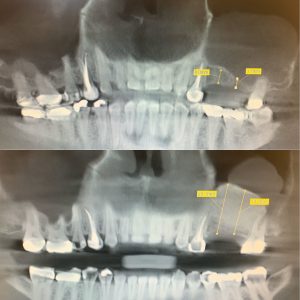Sinus Lift (Augmentation) Surgery
What is a Sinus Lift?
The maxillary sinuses are located in the upper jaw and above the roots of your back teeth. A sinus is an empty, air-filled space. Some of the roots of the our upper teeth extend up into the maxillary sinuses. When these upper teeth are removed, there is often just a thin wall of bone separating the maxillary sinus and the mouth. When the sinus wall is very thin, it is not possible to place dental implants in this bone, severely limiting your options for implants or implant-related procedures.
The key to a long-lasting success of a dental implant is the quality and quantity of jawbone to which the implant will be attached. If there is insufficient bone height from the sinus (due to old age, trauma, tooth decay, or periodontal disease), then our sinus augmentation precedure at North Texas Oral & Facial Surgery is recommended. A sinus lift can raise the sinus floor and allow for new bone formation, ensuring a stable and firm seat for your implant to sit and secure your new tooth. A sinus lift is one of the most common bone grafting procedures for patients with bone loss in the upper jaw, and is a safe and effective way to enable you for an implant procedure in the future. The procedure seeks to grow bone in the floor of the maxillary sinus above the bony ridge of the gum line that anchors the teeth in the upper jaw. By strengthening and growing bone in this location, dental implants can be placed and secured in the new bone growth for a smile that lasts a lifetime.

Am I a candidate for a Sinus Lift?
A sinus lift may be necessary if you:
- are missing more than one tooth in the back of your jaw.
- are missing a significant amount of bone in the back of your jaw.
- are missing teeth due to a birth defect or condition.
- are missing most of the maxillary teeth, but require support for dental implants.
Understanding the Sinus Lift Procedure
A sinus lift, also known as a sinus augmentation, is a common procedure that helps create a solid foundation for dental implants when there’s not enough bone in your upper jaw. It sounds complex, but it’s a well-established procedure with a high success rate. Here’s a breakdown of what you can expect:
Step-by-Step Guide to a Sinus Lift
Preparing the Area: Dr. Ganti will gently numb the area where the procedure will take place. A small incision is then made in the gum tissue to access the jawbone.
Lifting the Sinus Membrane: A small opening is carefully created in the jawbone, and the sinus membrane (the lining of your sinus) is gently lifted upward. This creates additional space for the bone graft.
Adding the Bone Graft: The newly created space is filled with a special bone grafting material. This material can come from your own body (often taken from another area of your mouth) or from a donor source. Over time, this material will integrate with your existing bone.
Closing and Healing: The incision is closed with dissolvable stitches, and the healing process begins. You’ll be given detailed instructions on how to care for the area while it heals.
Timing and Implant Placement
In some cases, if there’s enough existing bone, Dr. Ganti may be able to place your dental implant(s) at the same time as your sinus lift. However, if more bone is needed, the graft will need time to mature and integrate with your jawbone. This typically takes a few months. Once the graft has healed, you’ll return to our office to have your implants placed.
Comfort During Your Procedure
Your comfort is our priority. A sinus lift is generally performed using local anesthesia to ensure you don’t feel any discomfort during the procedure. However, if you experience dental anxiety or would simply like to be more relaxed, we also offer sedation options like oral conscious sedation or IV sedation. Dr. Ganti will discuss these options with you and help you choose the best approach for your needs.
